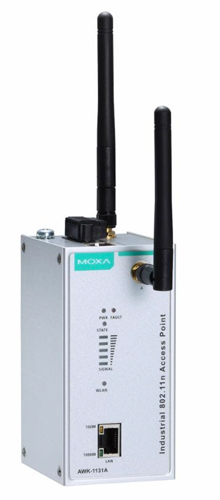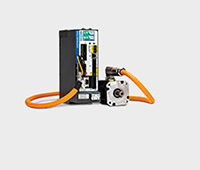Moxa is changing the way industrial networks connect with the introduction of the AWK-1131A IEEE 802.11n wireless AP/client. With high-speed transmission rates up to 300 Mbps, the AWK-1131A delivers a more fluid and stable industrial networking experience, along with proven reliability thanks to advanced protection against harsh industrial environments, including power surges, electrostatic discharge, broad temperature swings, and vibration from production machinery.
 “In today’s industrialized processes, we’ve entered an era in which standard or legacy networking devices are neither robust or fast enough to meet production expectations,” said Ariana Drivdahl, product marketing manager for Moxa. “However, by integrating extremely rugged features not typically seen in standard wireless products, such as electrostatic discharge protection and galvanic isolation on all interfaces, along with its lightning-fast 802.11n speed, the AWK-1131A is a major step forward for the industrial market, helping users manage the pace of change and address mission critical reliability issues.”
“In today’s industrialized processes, we’ve entered an era in which standard or legacy networking devices are neither robust or fast enough to meet production expectations,” said Ariana Drivdahl, product marketing manager for Moxa. “However, by integrating extremely rugged features not typically seen in standard wireless products, such as electrostatic discharge protection and galvanic isolation on all interfaces, along with its lightning-fast 802.11n speed, the AWK-1131A is a major step forward for the industrial market, helping users manage the pace of change and address mission critical reliability issues.”
According to Drivdahl, the benefit of galvanic isolation is that it breaks ground loops to help prevent unwanted current caused by different ground potentials from entering the device, therefore better protecting the AWK-1131A from voltage or other electrical surges up to 500V. In addition, Moxa has increased the electrostatic discharge (ESD) protection on the AWK-1131A’s power inputs and antenna ports to Level 4 isolation to prevent damage from external environmental sources.Remarkably, all this has been achieved within a form factor that is one of the smallest in the industry, measuring at a mere 2.29 inches wide, 4.53 inches tall, and 2.76 inches deep.
Like all Moxa networking solutions, the AWK-1131A includes software features that give it enhanced flexibility across a wide range of applications. For example, Moxa’s Turbo Roaming allows the AWK-1131A to roam almost instantly between access points, therefore ensuring a nearly constant wireless connection for complex applications, such as an automatic guided vehicle (AGV) navigating through a warehouse. In addition, Moxa’s MAC clone technology lets the AWK-1131A pass the MAC address of a connected device through to the network. This solves an issue for SCADA systems where end-devices such as PLCs are on Layer 2 networks, and both the device and the MAC address must be seen for proper communication.
The AWK-1131A can operate on either the 2.4 or 5 GHz bands and is backwards-compatible with existing 802.11a/b/g deployments to future-proof wireless investments. MIMO (multiple-input, multiple-output) technology increases data throughput and link range without additional bandwidth or increased transmit power.
There are a number of benefits to adopting wireless devices in industrial applications. Not only do wireless devices reduce deployment costs compared to wired devices, they also increase mobility for hard-to-wire applications while enhancing scalability when expanding the network backbone. With the release of the AWK-1131A, Moxa now offers a comprehensive portfolio with both single-radio and dual-radio IEEE 802.11n industrial wireless solutions for the bandwidth-hungry systems found in industrial environments.
Moxa
www.moxa.com
Filed Under: CONNECTIVITY • fieldbuses • networks, Wireless devices, MOTION CONTROL, Industrial computers





Tell Us What You Think!